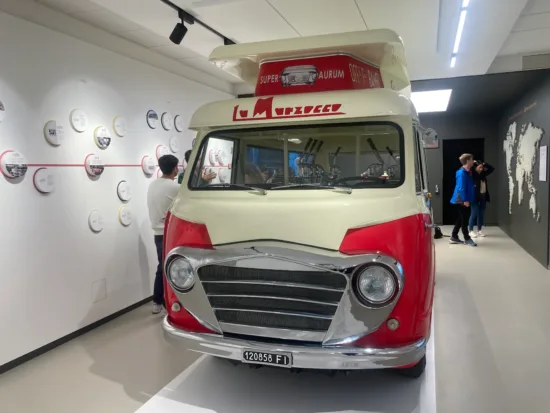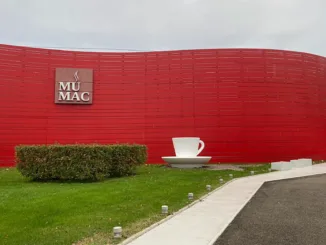
On the outskirts of Florence, La Marzocco’s Accademia del caffè espresso welcomes guests to the historic factory turned coffee academy.
BY TANYA NANETTI
SENIOR ONLINE CORRESPONDENT
Photos by Tanya Nanetti
I recently took a trip to Italy to finally make a long-awaited visit to La Marzocco Academy, or Accademia del caffè espresso, on the outskirts of Florence. After a scenic drive through the hills of Emilia-Romagna and Tuscany, bathed in a thick mid-November rain, I arrived at the historic factory of La Marzocco—the famous Italian company has been in the espresso machine business since 1927.
Welcome to Accademia del caffè espresso
At the entrance, Gioele, part of the La Marzocco hospitality team, greeted me with a friendly smile and took me through the main hall to the main bar to wait for the other academy guests. (The experience is booked in advance). And here I tried my first coffee of the day: a super-sweet, home-roasted washed Colombia.
While waiting, I looked around to get a peek of what the visit would hold. The hall is huge, with a massive library (containing every coffee book imaginable); a lush indoor coffee plantation; the bar; and a professional kitchen in the back, where chefs were already cooking delicacies for the upcoming lunch.

On the side, several spacious rooms house the Academy’s workshops. Individual classes cover everything from green coffee and roasting to sensory training and extraction.
Soon all the other guests had arrived, and it was time to start the tour.
The Historic Espresso Bar
Gioele led us into the exhibition area, where I realized there is much more to explore in the Accademia—starting with the first room, which houses a “historic Italian bar.“
The centerpiece of the room is a beautiful original bar counter from La Marzocco (which also produced counters, chairs, and other bar furniture from the 1960s to the 1980s). This one was once used in a small bar in Pistoia, and houses an original 1973 La Marzocco GS1. Gioele jumped behind the counter and prepared a classic blend of 60% robusta, bitter and dark, and suggested we try it with sugar!
As shocking as it can be to those who are used to a different flavor profile, this coffee experience serves a specific purpose. It allows visitors (especially Italian tourists) to enjoy a classic old-school Italian experience. It was paired with a homemade cantuccio, a delicious traditional Tuscan dessert.

Before moving on to the next room, I marvel at “The Fabric of Wonders.“ This amazing automated sculpture represents La Marzocco’s factory and offices with metal puppets, gears, platforms, and a video showing the production of a Linea Mini.
Gioele then introduced the exhibit, which was divided into three main areas covering the company’s history, the technology and innovation of La Marzocco, and the biology of coffee.
Technology Explained
First we visited the interactive room that covers the more technological aspects. We learned about the double boiler for espresso machines, invented and patented by La Marzocco in the 1960s. There was also a short video illustrating the history of the company. A Strada and a Linea Mini were exhibited, disassembled to show the multitude of parts that make up both machines.

Then it was time for one of the most interesting areas of the exhibit (at least for us nerdy baristas). We moved on to the collection of historical coffee machines, accompanied by an in-depth explanation of all the machines and their historical significance.
Antique Espresso Tech
The first machine was the Fiorenza, built in 1927. Only 12 were made, and only two remain. Most of the machines built before World War II were melted down during the war. The machine is built in the classic cylindrical shape of the time. It also features one of the first built-in steam rods to help relieve excess pressure, lowering the otherwise potentially high risk of explosion!
Next to it was the Rondine, an elegant lever machine from ’53, designed with both Vespa and Lancia lines in mind. The Rondine was nicknamed La Spacca Mandibole (The Jawbreaker) for the risk of having the 14kg lever (released by a spring after extraction) break your jaw!

Another highlight of the collection, but more for its history, is the GS71-81. This machine was used by Starbucks, in a historic partnership that lasted until Starbucks asked for a fully automatic machine, and La Marzocco declined. La Marzocco has always believed in the importance of the barista as the key figure behind a coffee bar; according to legend, many of the young baristas creating the first third-wave coffee shops around this time were using old (and cheap) espresso machines discontinued by Starbucks.
Finally, we saw a stunning replica of an original Alfa Romeo van from the early 1960s, used as a traveling showroom with an array of espresso machines. Its purpose? It would stop in front of cafés in city centers, inviting baristas to try their machines.

Leaving the collection, we moved to the last room. Here, interesting panels gave an overview of the origins of coffee. They illustrated four different plantations (of various origins) to share their many distinctions.
Once we were back in the main room, it was time for the second part of our visit, an optional coffee tasting. This was perfect for delving deeper into the magical world of specialty coffee.
Tasting Room
Simone Zaccheddu, coffee specialist for La Marzocco, expertly guided us through an interesting four-course tasting. First was a cascara-based drink (which, as Simone explained, is probably the oldest way to consume coffee). Then we tried the same coffee, a natural slow-dried Colombia, extracted in both V60 and espresso, to show how taste and texture can vary in different forms of extraction.

The last course, as a surprise, was an artisanal sorbet prepared with cold brew and invert syrup. The recipe was created in collaboration with Italy’s Carpigiani, one of the most famous brands of ice cream and gelato machines.
The sorbet was creamy and balanced, with a surprisingly intense coffee flavor in which you could recognize the specific coffee being used. This was the sweetest (and most intriguing) way to end the tasting.
In the blink of an eye, it was 1 p.m.—time to end the visit.
The Accademia restaurant is open for lunch. Most guests decide to stop and enjoy a typical Tuscan lunch, immersing themselves for a while longer in the magic of the Accademia, thinking back on the wonderful morning and highlights of the tour.

My favorite part was the collection of historical machines. For my companion Endri, it was the historic Italian café. A Canadian couple simply fell in love with coffee tasting, while two Roman friends (who knew little about specialty coffee up to that point) delighted in delving into the origins of coffee.
This confirms it: A visit to Accademia del caffè espresso offers something exciting for everyone.
ABOUT THE AUTHOR
Tanya Nanetti (she/her) is a specialty-coffee barista, a traveler, and a dreamer. When she’s not behind the coffee machine (or visiting some hidden corner of the world), she’s busy writing for Coffee Insurrection, a website about specialty coffee that she’s creating along with her boyfriend.
Subscribe and More!

Out now: It’s the December 2023 + January 2024 issue! Read it for free with our digital edition. And for more than three years’ worth of issues, visit our digital edition archives here.
You can order a hard copy of the magazine through our online store here, or start a subscription for one year or two.




